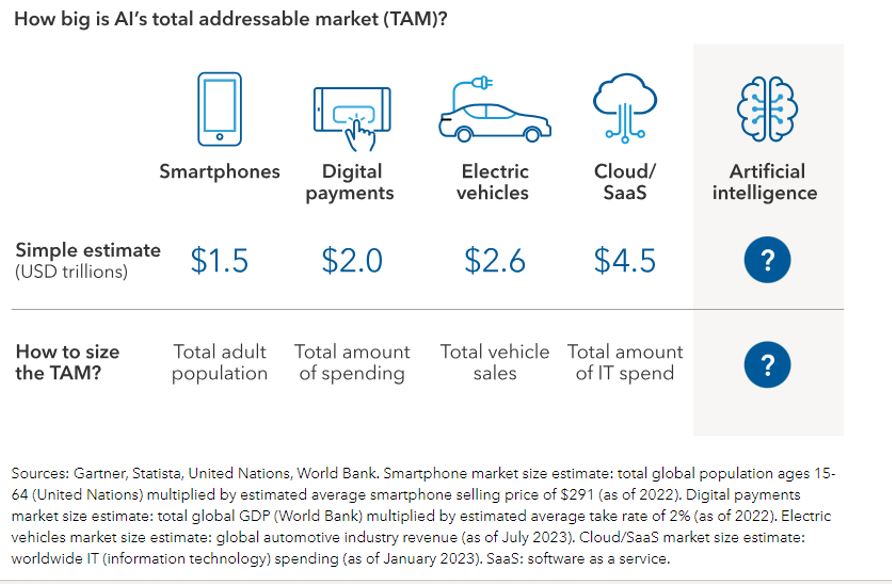Blog

“Separating AI Hype from Investment Opportunity“
I receive a lot of questions from clients around Artificial Intelligence, where it might go in the future, and what companies or trends make the most sense to invest in. While anyone’s answers to these questions are honestly a guess at this point, I thought this recent article from Capital Group did a good job laying the groundwork of what AI is and what areas might be the most ripe for AI investment. I hope you enjoy the reading too!
The artificial intelligence hype cycle has kicked into hyperdrive.
Newsfeeds bring daily reports of generative AI’s promise to accelerate medical and scientific discovery, drive leaps in productivity and eliminate jobs on a mass scale.
Businesses and individuals have rushed to adopt AI tools. OpenAI, developer of the ChatGPT chatbot, has reported that the tool had 100 million weekly users by the start of 2024, including two million developers and 92% of Fortune 500 companies.
Investor excitement has turbocharged share prices for the most visible enablers of generative AI, including NVIDIA, Meta Platforms and Microsoft, an investor in OpenAI. From 2023 through February 2024, the three tech giants soared 519%, 304% and 77%, respectively.
The question for investors: Has generative AI (GenAI) — which is defined as platforms and tools that can generate new content, including text, images, video and sound — launched a lasting megatrend, or has its potential been greatly exaggerated.
We believe generative AI represents a transformational shift that will lead to unprecedented investment opportunities. The challenge for investors today is to separate the hype from what matters: the pace of adoption, improvements in the models and price declines.

The AI market may be bigger than you think
With AI still in its infancy, it is difficult to estimate how large the market will be. The consulting firm McKinsey estimates that the AI market could reach $13 trillion by 2030, while PricewaterhouseCoopers assesses it could be $15.7 trillion by 2030. Meanwhile, Goldman Sachs has estimated it could boost GDP by 7%.
We believe the ultimate addressable market for AI is the hardest of any we’ve tried to size. After all, what is the “value” of better intelligence — or having more knowledge about everything? Simply put, AI has open-ended potential to generate a market many multiples larger than those of previous technological advances.
When the smartphone was popularized 15 years ago, combining internet and mobile phone technology, few could have predicted it would lead to new app-based business models like Uber and DoorDash. The breakthroughs in artificial intelligence represent similar potential.
What’s more, GenAI can analyze vast amounts of information and use pattern recognition to teach itself new tasks. This unlocks the potential to solve complex problems, uncover new insights and potentially lead to the creation of new business models.
Four ways early adopters are using AI
Companies are still in the experimentation phase with AI. Some IT consulting businesses, such as Accenture, have launched an initiative to help clients identify use cases for generative AI, adopt AI tools and integrate them into organizations.
Businesses are already seeking to tap into the efficiency and productivity gains AI can deliver. As much as 30% of hours worked in the U.S. could be automated by 2030, according to the McKinsey study.
Here are just a few ways companies are integrating AI into their businesses.
- Scientific and medical discovery
AI will likely accelerate discovery across various disciplines. Artificial intelligence can potentially process the totality of all know mathematics or physics or medicine in a very short time. For example, biopharma company Regeneron is harnessing GenAI tools to scour its massive database at its genetics center to identify disease targets, understand disease progression, develop drug therapies and track how individuals respond to treatment.
- Product development
Consumer products giant Procter & Gamble has begun using GenAI to improve molecular discovery, enabling it to develop, for example, 100 fragrance options at a time rather than one. As a result, they can respond to new product trends within months instead of years.
Among consumer tech offerings, Meta has developed AI sunglasses equipped with cameras that see what the wearer sees and microphones to hear what the wearer hears. The glasses enable users to take and share photos and videos and to listen to music. Users can also ask questions of the glasses like “what meals can I make with the ingredients on this table” or “who is the architect of the church I’m looking at.”
- Industrial automation and robotics
Amazon, which has long used industrial robots in its fulfillment centers, is applying AI to improve their efficiency and functionality. What’s more, robotics company Figure has harnessed ChatGPT to create a “humanoid” robot with audio and video inputs that can converse with and work alongside humans. Schneider Electric is developing a generative AI tool to communicate with customers about their carbon emissions. Construction and mining equipment manufacturer Caterpillar is investing in AI to boost productivity of its autonomous machines.
- IT services
Companies were already shifting several of their IT needs to the cloud and outsourcing more of their tech support. This trend is being amplified by the proliferation of GenAI, which has spawned a host of smaller companies that offer larger enterprises consulting and IT services that can evaluate and score the quality of content being created through the AI process, which can generate false or misleading information, known as hallucinations.
Other companies have been using GenAI to support call centers, improve financial models, create marketing and advertising content, analyze legal contracts, and develop employee training materials.
AI investment opportunities
While GenAI adoption has been most aggressive in the tech and media industries, its use has spread across industries and organizations.
Businesses worldwide invested an estimated $19.4 billion in 2023 to integrate AI into their processes, according to a Wall Street Journal report. While many are in the experimentation phase, AI has the potential to create massive productivity gains, reduce costs for companies and generate insights that provide a competitive edge for early adopters.
A unique U.S. Census data set released in March shows AI adoption at 5% in U.S. firms but expected to increase by 50% in 2024. That suggests we are still in the early stages of adoption. While the headlines may talk of mass unemployment and job loss, 95% of AI adopting firms reported no job loss and 65% reported no task loss. Other data in the report showed that firms that enable AI exposed to consulting, training and cloud could benefit from the transition.
Wider adoption can fuel continuous improvements that build upon each other, setting in motion a virtuous cycle of innovation and adoption. As more enterprises adopt GenAI, new and more sophisticated uses will likely emerge.
Rather than focus on attention-grabbing headlines about massive job loss or concerns about the coming of sentient robots, investors should focus on declining costs of AI adoption, advancements in models and identifying early adopters that may use the technology to gain a competitive advantage.
As active investors, that’s where we’re spending our time to uncover investment opportunities that might match the vast potential of generative AI.
